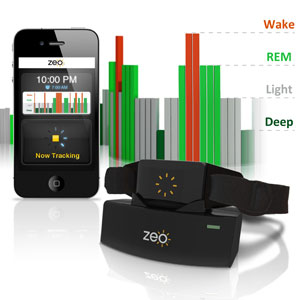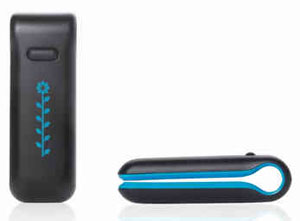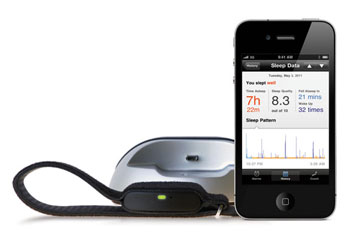We may earn commissions when you buy from links on our site. Why you can trust us.
Get a Longer More Restful Night's Sleep
The quantity and quality of your sleep can affect your health and that’s probably why there are so many body-monitoring gadgets that can track it. What’s even better, now there are several good ones that work in conjunction with your smartphone, which makes accessing your data simple.
 Zeo Sleep Manager (Mobile Version)
Zeo Sleep Manager (Mobile Version)
If you have some kind of issue with sleep or if it’s important to you, this is the system to get because unlike sleep tracking devices that use accelerometers to track how much your arm is flailing around at night, Zeo measures your brainwaves so it can actually see when you’re in the various stages of sleep: Deep, light and REM. It uses sensors embedded in a soft band that you strap around your head that measure the electrical activity in your brain. While you look a little funny wearing it and can it can leave marks on your head if you leave it on all night strapped too tight (it doesn’t need to be tight), it is the most accurate device I tested.
After charging the headband on the Zeo charging dock, you pair it with your iPhone or Android via Bluetooth. Then, after downloading the Zeo app to your phone, you simply put on the headband, open the Zeo app and it automatically starts measuring your brainwaves. Once you’re done sleeping, you just put the headband back on the dock to charge and monitoring stops.
You can see your sleep cycle using the easy-to-use and understand Zeo app. Zeo creates a timeline for each night and graphically breaks out into different colors when you were in various stages of sleep. It also gives you a ZQ score for each night and keeps a history of your sleep so you can see how it changes over time. If you sleep for eight hours and have several segments of deep sleep you might score a 97. Nap for a few minutes on the couch and you may get a 4.
You can also sync your data with the Zeo cloud platform where it will analyze your sleep patterns, give you recommendations and provide ongoing coaching delivered via e-mail.
I tested the Zeo app on both my husband’s iPhone and my Android smartphone, and it worked well on both, although on Android it was a slightly glitchy because I’m using Android 4.0 and the company officially only supports up to Android 2.3 (Zeo tells me it is ironing out any bugs in later versions). Sometimes when opening the app, the screen went dark but I got it started by closing then reopening the app a few times, tapping the screen a few times or hitting the back button. Also, to sync the phone with the cloud on Android 4.0 you need to tap the two small dots at the right-hand top of the screen, then Settings (which mostly didn’t fit on my phone’s screen, although I was able to tap it).
Cost: $89.73 on Amazon.com
.jpg) BodyMedia FIT, LINK Armband
BodyMedia FIT, LINK Armband
While this device tracks sleep, what you actually might like about this armband that you wear on your upper arm is everything else it does. Unlike some other health gadgets that only use an accelerometer to measure movement, this one uses four sensors to capture more than 5,000 data points per minute. To sync data from it to BodyMedia’s cloud platform, you pop the sensor module out of the armband and connect it via USB to your computer. There you can see many metrics involving calorie consumption and burning, physical activity and sleep duration. The platform also has a fitness coach that will make exercise suggestions or alert you if you exceed certain dietary recommendations.
And after downloading the BodyMedia FIT app to your iPhone or Android you can pair your phone to the app and see your metrics in real time or log foods you’ve eaten. There’s also a workout feature that lets you record a workout and set a timer, count steps, see how many calories you’ve burned and see if you can reach activity level goals. Currently the app doesn’t sync to the cloud platform in real-time (you have to use a USB connection) but the company says that functionality will be coming sometime this spring.
As a sleep tracking device, the armband isn’t the best one you can get. It shows numerically you how much time you spent lying down and sleeping and gives you a sleep efficiency score, and if you toggle your mouse over a timeline you can see if you were awake, lying down or sleeping at specific times throughout the night. However sometimes it said I was lying down (not sleeping) when I’m certain I slept through the night, so compared to the Zeo headband (which is very accurate) it said I was sleeping less than I really was.
The LINK armband itself is also on the bulky side. It’s noticeable under a well fitting shirt and some people might find the band with its extra weight a hindrance to sleep, although I didn’t. That said, BodyMedia does have an armband called CORE that’s one-third smaller than LINK, but it doesn’t have Bluetooth so it won’t work with your phone if that’s a feature you like.
Another downfall is the subscription you need to buy to use the armband and accompanying online platform and app. While the first three months are free, after that it’s $6.95 a month. However, for health fanatics or people serious about losing weight, it might be worth it, especially since its extra sensors, including one that measures Galvanic Skin Response, mean it can measure how many calories you’re burning more accurately than most other devices.
Cost: $199 for the Bluetooth-enabled LINK and $179 for the smaller CORE
on Amazon.com.
 Fitbit Ultra
Fitbit Ultra
This device, which is about the size of my little finger, is pretty nifty because you can wear it all the time and even forget you have it on, yet it will track the number of steps you take during the day, the number of stairs you’ve taken as well as measure how long you’ve slept. You just clip in onto an undergarment or pants pocket and it uses an accelerometer to track and record your movement. And if you have the charger plugged into your computer your data will sync to Fitbit’s online platform wirelessly if you’re sitting next to it for a few minutes. If you’re not by your computer, just press the power button briefly to light up your real-time metrics right on the front of the device.
To track your sleep using the Fitbit Ultra, you slide it onto a soft wristband that you wear while sleeping. To initiate tracking, you press and hold the power button which turns on a timer. When you wake in the morning, push and hold it again to turn off the timer and it will display how long you slept. When your data syncs with the cloud again, you can go online to see on a timeline how much time you slept or were active. So if you get up in the middle of the night and move around, that time will show as a spiked red area on your sleep timeline. The time you spent not moving in bed shows as blue.
As for accuracy, when comparing the Fitbit Ultra’s data to the Zeo (a very accurate device), the Fitbit was off. In one instance Fitbit Ultra added a half hour to my actual sleep time compared with the Zeo.
The real beauty of the Fitbit, in addition to its small size and clip-on form, is the online platform that you use to track your progress reaching health goals. Your dashboard there shows your activity for each day and lets you log anything you’ve eaten, activities, weight (you can link to a Withings scale account to import weigh-ins), sleep, mood, energy levels, heart rate, blood pressure and glucose readings.
In short, Fitbit Ultra is an unobtrusive device that gives you a good idea how much you’re moving throughout the day and a great platform for recording all sorts of health metrics. It’s a fun and robust place to hang out online and likely to be very motivating to people who want to see improvements in their health.
Cost: $93.35 on Amazon.com.
 Lark Pro
Lark Pro
You wear this matchbox-sized sleep-monitoring device on your wrist at night and it works with an iPhone app to help determine what type of sleeper you are and deliver a custom sleep program. Initially it spends a week establishing your sleep baseline by tracking when you usually go to bed, how many hours of sleep you’re getting and how often you wake up.
Turning on the alarm in the Lark app tells the device to start monitoring your sleep. Using the app in the morning to turn off the alarm—which vibrates instead of making noise—initiates the data transfer from your Lark device to the Lark app. So within seconds of waking, you can check out last night’s sleep cycle. You can see how long it took to fall asleep, how many times and when you woke up and your sleep score on a scale of 1 to 10.
You also get a set of personal goals to help you achieve the next level of better sleep as well as tips and other reminders on your iPhone to help your get a better night’s sleep.
Cost: The Lark Pro is $159 and includes one year of sleep coaching. If you don’t need ongoing coaching you can get the base model for $99. Both are available at Lark.com.















